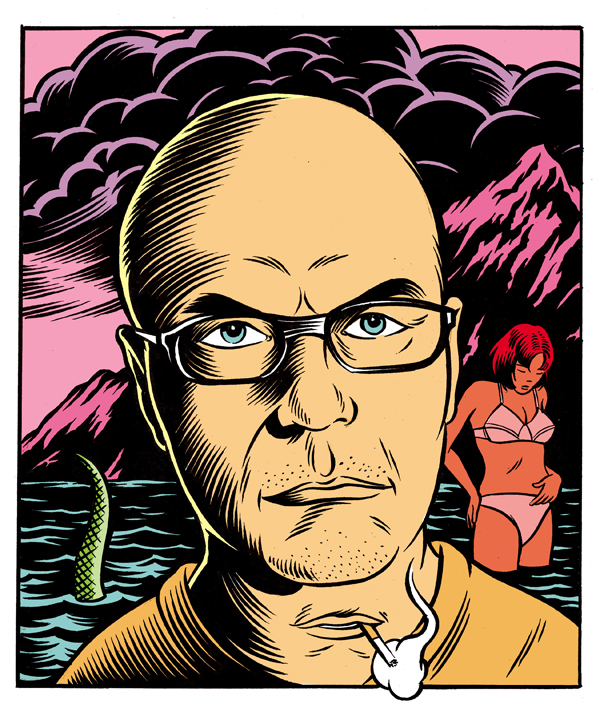Illustration by ALEX FINE
EDITOR’S NOTE: Cartoonist/illustrator Charles Burns, master of the punk-noir macabre, will be discussing his work at the Free Library tonight. To mark the occasion, we sent him some questions about The Hive (Random House), the just-published second installment of his new graphic novel trilogy, his first major work since 2005’s Black Hole. However, before we get to the Q&A, there are 10 things you should know about Charles Burns. They are..
1. Though born and bred in the high rainyland of the Pacific Northwest, Charles Burns has resided in Philadelphia — Northern Liberties, to be exact — for the past 23 years. “Well, the view out my studio window has changed a bit,” he says, when asked how the ‘hood has evolved over the years. “It used to be homeless guys pushing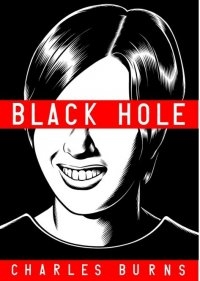 shopping carts, now it’s mothers pushing strollers.”
shopping carts, now it’s mothers pushing strollers.”
2. Mr. Burns is probably the most important graphic novelist of his time. He we would never agree to this, so don’t bring it up if you see him.
3. The monster-fying sex plague afflicting the horndog stoner teens — half-remembered, half-made-up stand-ins for the friends and exploits of his gloriously misspent youth circa mid-70s Seattle — that people the dark core of Black Hole is not really a metaphor for AIDS. But you would be forgiven for thinking so. “I suppose you can’t write a story about a sexually-transmitted disease without somebody asking you that, but really I just put that in to add to the sense of alienation and the desperation of these circumstances. If it’s a metaphor for anything it’s my tormented adolescence.”
4. Mr. Burns thinks women with tails are sexy. And he will make you think so, too. One of the characters in Black Hole is a beautiful and mysterious artist with more than just the usual junk in the trunk. “I think there is something alluring about it,” he says. “From time to time I do get women coming up to me and telling me how they had a tail when they were born.” Fascinating, captain.
5. Mr. Burns is married to Susan Moore, a painter and fine arts professor at Tyler School of Art. She does not have a tail. Together they have two daughters, aged 18 and 21. “Um, yeah, I guess they are grown-ups,” he says when asked for confirmation. “I am still trying to get used to that idea. It just kinda happened.”
6. Mr. Burns has TERRIBLE handwriting — “Even when I try really hard,” he says with mild exasperation — which is odd for one so adept at drawing clean and exacting lines with pen and ink. But as such, it falls to his wife to do all the lettering in his comics. “I had been sweating over a page for hours, trying to get the lettering to look good, and my wife looked at it and said ‘that looks REALLY terrible’, and I said something to the effect of ‘if you think you can do better…’ and she’s been doing it ever since.”
7. It takes a LONG time to make Black Hole. Serialized through the 90s in 32-page comic book installments once or twice a year, Black Hole has since been published in complete book form. It took Mr. Burns the better part of a year to finish each 32-page installment. “But that wasn’t working on it all day, every day,” he clarifies. “You see, the comics aren’t really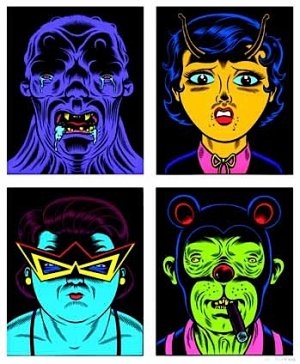 my day job. My day job is being an illustrator.” He is referring to the mesmerizingly weird, yet high-profile illustration work he does for the likes of Time, Coca Cola, The New Yorker, Altoids, The New York Times and The Believer. An admitted insomniac with a fairly tireless work ethic, Mr. Burns often begins his work day at three in the morning.
my day job. My day job is being an illustrator.” He is referring to the mesmerizingly weird, yet high-profile illustration work he does for the likes of Time, Coca Cola, The New Yorker, Altoids, The New York Times and The Believer. An admitted insomniac with a fairly tireless work ethic, Mr. Burns often begins his work day at three in the morning.
8. Mr. Burns is very stingy selective with his seal of approval. He is too nice to mention all the bands he declined to draw album covers for, but Iggy Pop is not one of them. “Virgin didn’t have to ask me twice,” says Mr. Burns, an avowed Stooges fan, when asked how he wound up drawing the cover to Iggy’s Brick By Brick. “So basically they were like ‘Do a cover, show it to Iggy and if he likes it we’re done.’ So they give me the address and I go up to New York. Iggy was very nice and normal and it just so happened that Allen Ginsberg was visiting when I showed up. So we all sat around and looked at the cover. Iggy just laughed. I took that as a yes.”
 9. He recently finished work on an animated feature-length film called Peur(s) Du Noir (Fears Of The Dark). Mr. Burns is one of six artists (and one of only two Americans) invited by a French production company to write, direct, and shoot a segment of the highly expressionistic film. Peur Du Nour premiered at Sundance back in 2008.
9. He recently finished work on an animated feature-length film called Peur(s) Du Noir (Fears Of The Dark). Mr. Burns is one of six artists (and one of only two Americans) invited by a French production company to write, direct, and shoot a segment of the highly expressionistic film. Peur Du Nour premiered at Sundance back in 2008.
10. In closing, Mr. Burns has never killed anyone, has never voted Republican, and does not believe in God. He does recycle, is well-liked by animals and small children, and he went to college with Matt Groening . He is curiously cagey about whether or not the character of Charles Montgomery Burns is in fact named after him. “You’d have to ask Matt,” says Mr. Burns. “But I will say this, one time I was at some public event [with Groening] and somebody in the audience asked that very question. Matt said, ‘You have to ask my lawyer.’” — JONATHAN VALANIA
does recycle, is well-liked by animals and small children, and he went to college with Matt Groening . He is curiously cagey about whether or not the character of Charles Montgomery Burns is in fact named after him. “You’d have to ask Matt,” says Mr. Burns. “But I will say this, one time I was at some public event [with Groening] and somebody in the audience asked that very question. Matt said, ‘You have to ask my lawyer.’” — JONATHAN VALANIA
PHAWKER: The Hive, the just-published second installment of your mesmerizing new trilogy, picks up where the first installment, X’d Out, left off. As per usual, it is fairly mind-blowing — deeply engrossing and deeply unsettling all at once. There are two realities in the trilogy. One concerns an art school student who falls for a classmate, a beautiful but deeply troubled girl who has a physically abusive ex-boyfriend that’s stalking her. It hasn’t been explicitly laid out yet, but it is strongly implied that in a fit of jealousy the psychotic ex-boyfriend has inflicted unspeakable violence upon the art school student. The second reality takes place in some strange, foreign land — 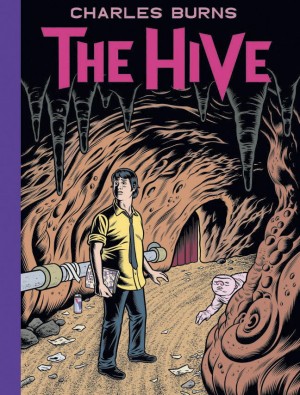 possibly another planet — peopled by surly Mongoloidal dwarves dressed in tighty-whities and foul-mouthed lizard men that are conducting some kind of mass breeding operation inside a giant hive, located in the center of town, that resembles the cooling tower of a nuclear power plant. The book moves back and forth between both realities — usually triggered by a character slipping into unconsciousness, be it through sleep, alcohol or drugs — and there is a prevailing sense of deja vu, events in one reality seem to have echoes in the other reality. The reader is largely kept in the dark about what exactly is going on and where this is all heading. We are adrift in the stream of consciousness, floating downstream on the currents of your making. My question is this: do you map out the entire story in advance or are you just making this shit up as you go along?
possibly another planet — peopled by surly Mongoloidal dwarves dressed in tighty-whities and foul-mouthed lizard men that are conducting some kind of mass breeding operation inside a giant hive, located in the center of town, that resembles the cooling tower of a nuclear power plant. The book moves back and forth between both realities — usually triggered by a character slipping into unconsciousness, be it through sleep, alcohol or drugs — and there is a prevailing sense of deja vu, events in one reality seem to have echoes in the other reality. The reader is largely kept in the dark about what exactly is going on and where this is all heading. We are adrift in the stream of consciousness, floating downstream on the currents of your making. My question is this: do you map out the entire story in advance or are you just making this shit up as you go along?
CHARLES BURNS: Hah! I’d love to say, “I’m making this shit up as I go along” just because it sounds a whole lot funnier but actually I’m constructing a story that has a beginning, middle and end and the basic structure of the story has been in place since I started. That being said, I’ve allowed myself plenty of room for the story to unfold in unanticipated ways. In “real life” I feel incredibly inarticulate most of the time, but by slowly piecing together images and ideas and narrative and dialogue I manage to get a little closer to expressing the seemingly scattered ideas that make up the plot of this series of books.
PHAWKER: The comic book/graphic novel format is well-suited to revealing the interior lives of characters, and your contemporaries in the graphic novel genre make extensive use of that latitude. We literally watch them think as they puzzle through things, recover old memories or hallucinate new ones. Your books seems to go a step further, in that they don’t just mimic the ebb and flow of consciousness, they seem to embody it. They are consciousness. That’s a pretty neat trick. What’s the secret?
CHARLES BURNS: No tricks other than paying close attention to the way my brain functions. I sit and write every day and it amazes me how often I repeat myself – 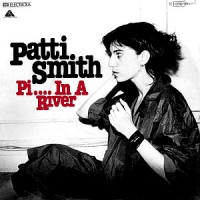
come up with the same “brilliant” solution to a plot thread only to discover notes from years earlier where I’ve already clearly laid out the same ideas. Perhaps it has something to do with the fact that people have a tendency to repeat stories that are important to them over and over again. I’m trying to tell those stories I’ve internalized but make them come to life in a way that doesn’t come off like, “Hey, I had this really, really weird dream and… and…”
PHAWKER: Was the plot line of the art school student brutally assaulted by the psychotic ex-boyfriend of the girl he is seeing inspired by a similar incident that actually happened here a few years ago?
CHARLES BURNS: Actually it was inspired by a similar incident that happened to me.
?PHAWKER: One of the characters in the trilogy is obsessed with Patti Smith’s Radio Ethiopia, specifically the song “Pissing In A River.” Why Patti Smith, why that song? Is that just incidental or is it somehow crucial to the story? Is it connected to the books’ recurring images of a fetid, Stygian river?
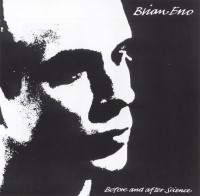 CHARLES BURNS: I can tell by your questions that you’ve done a very careful reading of my story but I’m reluctant to “explain” it all away… kind of ruins it when there’s a black and white answer. But yeah, there’s plenty of river imagery and plenty more to come. I could make a list of “hints” but that seems like it would be irritating… Patti Smith? My girlfriend’s roommate was obsessed with Radio Ethiopia and played that record nonstop when it came out way back when.
CHARLES BURNS: I can tell by your questions that you’ve done a very careful reading of my story but I’m reluctant to “explain” it all away… kind of ruins it when there’s a black and white answer. But yeah, there’s plenty of river imagery and plenty more to come. I could make a list of “hints” but that seems like it would be irritating… Patti Smith? My girlfriend’s roommate was obsessed with Radio Ethiopia and played that record nonstop when it came out way back when.
??PHAWKER: Another character breaks down crying every time she hears an un-named song on Brian Eno’s Before And After Science. What is the song? I’m guessing first song, “By This River”? Again with the river.
CHARLES BURNS: If we were having this conversation in person, I guess I’d be nodding my head in an affirmative manner. Uh-huh, uh-huh. But maybe someone will read that passage and then search out Before And After Science and… and maybe that would fun for them to discover.
PHAWKER: Balthus‘ creepy portrait of Joan Miro and his daughter makes an appearance. Why Balthus? Why that painting?
CHARLES BURNS: I promise I’m not trying to duck your questions, but I don’t think if will improve anyone’s reading of the book by explaining the references I’ve 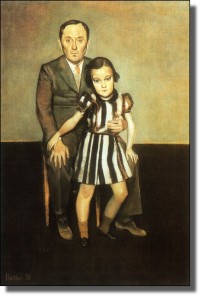 included. The best I can do is tell you that the experiences of the main character mirrors some of the experiences I had in the late seventies, and spilling over into the early eighties. I attended art school, I was in a band called “Johnny 23”, I took SX-70 photos (and tried my best to imitate Lucas Samaras but failed miserably), I made a little house out of cardboard and took photos of my girlfriend wearing it on her head, I had folders and notebooks filled with photocopies of artwork I responded to (including the Louise Bourgeois drawing/print I included in my story), I watched a whole load of early punk concerts in the San Francisco and Seattle, I had friends that were in some of those bands, I cut my hair short and wore suit jackets and skinny ties and… and… I had a friend who carried around pig fetuses and took photos of them in odd places and…
included. The best I can do is tell you that the experiences of the main character mirrors some of the experiences I had in the late seventies, and spilling over into the early eighties. I attended art school, I was in a band called “Johnny 23”, I took SX-70 photos (and tried my best to imitate Lucas Samaras but failed miserably), I made a little house out of cardboard and took photos of my girlfriend wearing it on her head, I had folders and notebooks filled with photocopies of artwork I responded to (including the Louise Bourgeois drawing/print I included in my story), I watched a whole load of early punk concerts in the San Francisco and Seattle, I had friends that were in some of those bands, I cut my hair short and wore suit jackets and skinny ties and… and… I had a friend who carried around pig fetuses and took photos of them in odd places and…
PHAWKER: The Mod Squad makes a brief appearance as well. Why?
CHARLES BURNS: See above…
PHAWKER: The guitarist in the band playing at the hipster warehouse party is a dead ringer for Johnny Ramone. Coincidence?
CHARLES BURNS: See above…
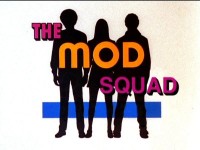 PHAWKER: The sculptor Louise Bourgeois is referenced in The Hive. Why her?
PHAWKER: The sculptor Louise Bourgeois is referenced in The Hive. Why her?
CHARLES BURNS: And see above…
PHAWKER: The artist Lucas Samaras is referenced in X’ed Out. Aside from the fact that his work is literally incredible, is there some deeper meaning behind his inclusion that I am missing?
CHARLES BURNS:…and again.
PHAWKER: The Hive concludes with a man buying a Sugar Skull (literally a skull made out of sugar that is used in the celebration of the Day Of The Dead in Mexico) from some vendors along the road. The skull is inscribed with the letters of some strange alphabet he can’t read. Later he finds out the letters spell out I WAS YOU. I got douche chills from that, and I’ve never even 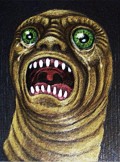 douched. I suppose this could be asked about just about everything in your work, but where on Earth did the idea for that plot element come from?
douched. I suppose this could be asked about just about everything in your work, but where on Earth did the idea for that plot element come from?
CHARLES BURNS:…again. As I said, it’s obvious you’ve done a close reading and I appreciate that. I know I sound like a smartass but I just don’t wanna explain away my story.
PHAWKER: The worm with the human face and big sharp teeth — which also gives me douche chills — is a recurring image in your work. What’s that all about?
CHARLES BURNS: I dunno. I guess I just relate to worms.
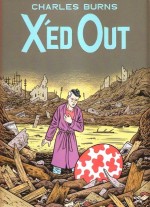 PHAWKER: Lastly, you have lived in Philadelphia, more specifically Northern Liberties, for going on 25 years. What impact, if any, has the city or your neighborhood had on your work? Obviously I’m going for some of that David Lynch/Eraserhood thing, so don’t let us down, Mr. Burns.
PHAWKER: Lastly, you have lived in Philadelphia, more specifically Northern Liberties, for going on 25 years. What impact, if any, has the city or your neighborhood had on your work? Obviously I’m going for some of that David Lynch/Eraserhood thing, so don’t let us down, Mr. Burns.
CHARLES BURNS: We moved to Northern Liberties in 1986 because it was what we could afford. There was a business across the street from us that “processed” chickens and it could get pretty nasty in the hot, humid summers. I used to look out my studio window and watch homeless guys pull discarded, raw chicken out of a dumpster and cart it away for eventual consumption. These days instead of guys pushing shopping carts I see attractive young couples pushing their expensive baby strollers.
CHARLES BURNS & CHRIS WARE WILL DISCUSS THEIR NEW WORK TONIGHT @ THE FREE LIBRARY

